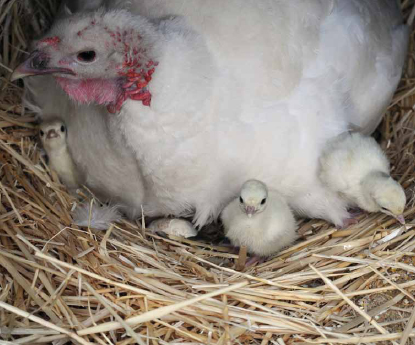
Heritage Turkeys (and Chickens) Are More Sustainable, and They Have More Fun
OVER THE PAST FEW YEARS, heritage turkeys have spent some well-deserved time in the spotlight. A Internet search shortly before last Thanksgiving revealed an impressive number of growers offering them for sale. If you were one of the many who shelled out a few extra bucks for one of these popular birds, what made you choose a heritage breed? Novelty? The trendiness of it all? Before you prepared and ate it, did you really know what makes a heritage breed different or better than the normal frozen supermarket variety?
I know I’ve said this before, but I think it bears repeating, especially if you’re interested in raising turkeys and want to make a thoughtful choice. A “heritage” breed is a purebred, or standard, bird, while the usual commercial turkey is the faster-growing Broad Breasted hybrid. Heritage breeds are also defined as breeds that are “naturally mating” types. Yes, you heard right: Heritage-breed turkeys mate naturally; hybrids, mostly owing to their unnaturally large breasts, cannot mate. They must be artificially inseminated.
As David noted wryly, someone has to do it, but how would you like that job on your résumé?
Apparently, in someone’s estimation, the minor inconvenience of artificial insemination is offset by the faster growth that brings them to your grocer’s freezer two to three months faster than the heritage breeds. In addition, without artificial insemination, turkeys would not be available year-round. And if you do the math, you’ll discover that, when turkey eggs are hatched in mid- to late spring, the babies are reaching slaughter size right around late November. I’ve never heard anyone else speculate about this, but I certainly have wondered if that’s the real reason turkeys are so closely connected with the Thanksgiving holiday.

Mom turkey with new hatchlings.
What if you don’t want to raise turkeys yourself, but you do want to be a more responsible and informed consumer? If you are serious about learning more about where your food comes from, you have probably already started to think beyond the garden or greenhouse. See if you can find someone who raises poultry — it’s really not hard these days — and start asking questions. If you live in a big city, ask at your local grocery or co-op. If your store doesn’t offer heritage turkeys, they might be willing to order one for you. (Chapter 30 offers more ideas about connecting with sources of heritage poultry.)
Midget White turkey family out for a stroll.
By the way, “heritage” applies just as much to chickens as to turkeys (as well as other types of livestock). Many of these historically important breeds are now endangered. Heritage-breed meat chickens in particular have had a tough time since the ridiculously fast-growing Cornish-Plymouth Rock hybrid was developed in the 1950s.
There are just as many good reasons to buy and enjoy heritage chicken ... if you can find it. If you’re like most people, you eat chicken more frequently than turkey. I heard that, later in her life, Julia Child regularly bemoaned the disappearance of the stewing hen from the grocery store meat section. The poultry industry favors the male Cornish Cross chickens because of their faster maturity, although the difference is only a week or so between males and females. Knowing what I know now, I think it’s sad that the profit margin has become such an issue that slaughtering a chicken at six weeks is so different from slaughtering one at seven weeks.
I also suspect that the ‘Rock Cornish Game Hen’ is an idea someone came up with to deal with surplus Cornish Cross chicks at the hatcheries. (The “Rock” comes from the Plymouth Rock chicken, which is crossed with the Cornish chicken to produce the Cornish Cross.) And a clever marketing solution it was: Slaughter the pullets at two pounds (live weight), change the name of the birds a little bit, and hey presto, we now have an exotic-sounding miniature chicken that can be sold for much more per pound than their male siblings. It reminds me of the equally clever story behind the portobello mushroom. But don’t get me started on that one.